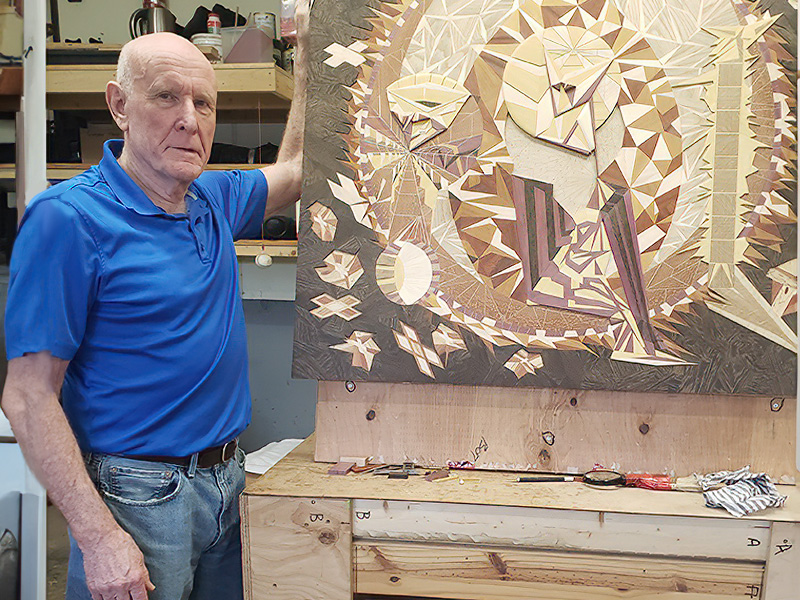Martin Askew
Local artist creates elaborate works in wood to explore themes and tell stories
Visual artists use a lot of different materials to create work. Some use oil paint. Some use acrylic. Some use ceramics, or bronze, or granite. Others glass and glue.
Martin Askew uses wood.
The 74-year-old Calgary artist creates elaborately designed paintings — or their visual equivalent — created with thousands of pieces of wood pieced together in intricate visual detail. There are 14 or 15 different species of hardwood in each work of art, and they all have their own colour.
Don’t ask him to choose a favourite, though.
“I don’t have a favourite wood,” he says, in an emailed reply to a question. “They are comparable to human beings, I have never met one exactly the same.
“The different colours of wood leaves humanity at the starting line,” he says. “Wood is light years ahead as far a colour goes. A painter in the art world has to mix their preferred colour, I have the advantage of a half-billion years of nature’s ability through natural selection, that allows me to choose colour readymade, complete with a visible cell structure, veins, density, texture, different weights and — need I go on?”
Walking into Askew’s studio — the garage of his home in Edgemont, in a northwest Calgary suburb — is like walking into a forest of sorts. It smells magnificent.
But the effort required by Askew to assemble a single work is staggering — one of Askew’s elaborately designed pieces, The Art of Reconciliation, contains around 4,000 pieces that he must first design and then carve.
It’s sort of akin to dreaming up your own Lego design, then building thousands of bricks before assembling them. Although for Askew, it might just be a variation on muscle memory — he was a Calgary home builder for decades before retiring and going into the garage to create his wooden wonders full-time.
All of which raises a question: Why wood?
“It was once alive just like me, “ he says. “It has been on the planet for more than a half-billion years and I get the privilege to bring it back to life.”
‘Anything in wood, boy’
Maybe it’s the connection between all those decades of building people’s homes and the creative life he pursues now. Askew grew up in Norwich, England. At 14, after spending a period of time as a student at the Norwich City Art School, he began an apprenticeship at a firm known as H.R. Wilkie and Son, which led to studying at Norwich City College.
“Through my apprenticeship I worked on many structures, some made of stone such as flint stone, sandstone, York stone, a multitude of bricks, plus cutting into walls made of twigs, straw (and) cow dung mixed with mud,” he says. “When I came to Canada, I was astonished to see homes constructed all in wood.
“I have built and worked on many homes in Canada in my early days,” he says. “I personally worked on my own homes starting on the foundations all the way up to the roof and finishing the complete interior woodwork, plus making furniture for my clients’ new home.
“The battle cry my old mentor Ernie Robertson would say over and over again,” he says, “was:
“Anything in wood, boy — we can do it!”
Epic Themes
Askew’s work explores themes that blend science, spirituality and the environment as well as the troubled and traumatic relationship between the Canadian government of the early 20th century, the church and First Nations peoples. If you look closely at The Art of Reconciliation, there’s a red dress, paying tribute to Murdered and Missing Indigenous Women and Girls.
The red dress is framed by a question mark, and a dreamcatcher, because, Askew says, all the parents have left of those missing women and girls, as well as the children who never came home from residential schools, are their dreams of them, as they try to answer the question of what became of them.
One Life is Askew’s effort to put a visual map to the inside of the conscious mind. That one was partly inspired by the time, when he was 60, he had a brain aneurysm, an event that left him hanging by a thread in a hospital bed, where the doctor told him he might be dead any minute.
After a few minutes, Askew said, “I’m still here!” Then, with his wife comforting him as his life hung in the balance, he told her, “If it’s over, I’m good. I’ve had an absolute blast.”
That was 14 years ago and Martin Askew is still going.
Consciousness
In addition to his wood ‘paintings,’ Askew creates wood sculptures, such as F-4, which is an imaginative look at what it might be like inside a tornado — or three.
Another sculpture NFE — Not From Earth — evokes a Brad Bird Pixar movie like The Iron Giant blended in with Japanese armour created in the Samurai era. It’s pretty wild.
In fact, while his art making material is literally rooted in the land, his imagination is full of questions about life or consciousness beyond earth. All of which brings our conversation around to Star Trek, and its legendary creator Gene Roddenberry, who was so far ahead of his time in the mid-1960s he doesn’t even seem to have been from Earth.
Using different types of wood, Askew has created a visual map of the universe of sorts, a topography of infinity, a landscape of the universe — or, it’s pointed out, a kind of wooden model of something that could be a set from the latest Guardians of the Galaxy sequel. “I hope,” he says, “When we go into space, we don’t take religion.”
He may have gotten a late start to his artmaking life, but in April he was featured on CTV News, which resulted in lots of interest in his unique blend of the artisanal and the existential.
Askew has also written a memoir of his teenage years, from the age of 14 to 19, called From Apprentice to Artisan. It tells the story of his coming of age as a tradesman and artisan during his teenage years in England. At 15, he says he found himself surrounded by artisans. At 20, he became one of them.
It was in Norwich, as a child, where Askew remembers first exploring the power of imagination and creativity, when his mum told him there was something for him out back. That’s where he found a large steering wheel from a bus, which prompted him to imagine transforming his parents’ flat into something he could take for a spin around the block.
“For the first time in my life my imagination engaged,” he says, “I hit the reverse gear and my whole house, 47 Hunter Road, disengaged from its foundation as I backed out onto Hunter Road with my mother intact in the kitchen — off I went for a cruise around my neighbourhood.”
He was four years old. Seven decades later, Askew continues to nurture and feed his imagination.
“That young Martin is alive and well within the older 74-year-old Martin of today,” he says. “That is how I live a creative life,” he added. “By keeping my youthful imagination alive and well and with it my neighbourhood has now expanded, allowing me to cruise the universe.”
About the Storytelling Project
The Storytelling Project raises awareness about Calgarians who, by living creative lives, are making Calgary a better city, effecting positive change and enriching others’ lives.
Have a story to share? Email us at submissions@calgaryartsdevelopment.com.

